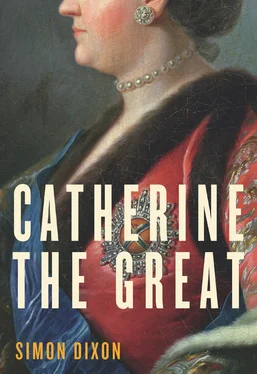Noticeably missing from the empress’s working day was any collective meeting of her advisers. Although she had initially been tempted to accept Panin’s proposal for an imperial council of between six and eight aristocrats, she soon rejected the idea as a potential limitation on her own absolute power. While Panin had made his suggestion in December 1762 as a way of preventing a recurrence of the arbitrary favouritism of Elizabeth’s time, Catherine almost certainly suspected a bid to enhance his own influence at the expense of the Orlovs. Although the idea was quietly shelved, the membership of the Imperial Assembly, secretly formed in Moscow on 11 February 1763 to determine how to respond to Peter III’s manifesto on the nobility, was much the same as Panin had projected for his council. Meeting some twenty-one times before the end of October with the ubiquitous Teplov as its secretary, this informal but highly influential body became, in effect, the Russian government. In a balanced representation of elite political interests, Panin and Grigory Orlov were joined by Bestuzhev, Kirill Razumovsky, Mikhail Vorontsov, Yakov Shakhovskoy and Zakhar Chernyshëv, whom Catherine had put in charge of the College of War. When the Court returned to St Petersburg, the Assembly extended its remit to consider a root-and-branch reform of the Senate, much as Panin had originally intended. 29Catherine was delighted. At the time of her accession, she later complained, ‘the Senate regarded it as excessive to hear state business with a map on the table in front of them’, so that ‘sometimes they did not know what they were judging. Shameful to say, there was not a single printed map in the Senate, and indeed, being present there, I sent for the first one to be bought from the Academy [of Sciences].’ Always a scourge of laziness and inefficiency, she sent the Senators a long list of personal orders that they had failed to fulfil, insisting that they attend their office for four hours every morning and for three afternoons a week until the backlog had been cleared. 30
In January 1764, Glebov was replaced as the Procurator-General of the Senate by Alexander Vyazemsky, who was to dominate the Russian bureaucracy until his death in 1792. The instruction Catherine sent to him on his appointment is rightly considered as ‘one of the most important documents illustrating her conception of statecraft’. Ordering him to remain above and beyond factional conflict and to trust in her alone, she explained what he could expect in return:
You will find that I have no other view than the greatest welfare and glory of the fatherland, and I wish for nothing but the happiness of my subjects, of whatever order they may be. All my thoughts are directed towards the preservation of external and internal peace, satisfaction and tranquillity. I am very fond of the truth, and you may tell me the truth fearlessly and argue with me without any danger if it leads to good results in affairs. I hear you are regarded as an honest man by all; I hope to show you by experience that people with such qualities do well at Court. And I may add that I require no flattery from you, but only honest behaviour and firmness in affairs. 31
She was as good as her word. Conscious of the fate that had traditionally befallen most advisers of a disgraced monarch in Russia, Peter III’s leading minister, Dimitry Volkov, assumed that his time had come. Yet he, too, found that he had nothing to fear. ‘I am always delighted when I see a swift attitude to business and an earnest approach to service in my subjects,’ Catherine assured him. ‘When subjects wish to see an industrious and solicitous sovereign taking care of their interests, then the sovereign is no less happy to see her subjects helping her. Don’t bother about your circumstances: just get on with the job, because your reasoning is good. Upright service will always rectify circumstances, of that you should have no doubt.’ 32Having proved his efficiency as governor of Orenburg, Volkov was recalled to St Petersburg in 1764 to take charge of the College of Manufactures, where he remained until retiring age. Long periods of office were to be the norm in the new reign, even for some of the families whose loyalty Catherine initially had reason to doubt. Since the pool of available talent was limited, she was even prepared to give jobs to the aloof Vorontsovs. Count Alexander Vorontsov, brother of Peter III’s mistress, was president of the College of Commerce for twenty years from 1773, his brother Semën a long-serving ambassador in London. ‘Tolerate an unpleasant person in your sight,’ the empress later exhorted her infant grandson, the future tsar Alexander I, ‘and do not glance askance at him: a man who can get on only with people he likes, and not with those he does not, is lacking in wisdom.’ 33
* * *
The nerve centre of Catherine’s government was the Winter Palace, still under reconstruction when the Court returned from Moscow, though not under the direction of its original architect. Having been close to Peter III, Rastrelli thought it prudent to take temporary leave from Russia shortly after Catherine’s coup. When he returned a year later, he found that his circumstances had changed for the worse. Among the petitions forwarded to Yelagin’s secretariat in the autumn of 1763 was one from the disgruntled architect:
Your holy Imperial Highness, I am taking the liberty to inform Your Imperial Majesty with the most humble respect that, having received permission to return to Italy for a year thanks to Your kindness, and having received at that time a gift of 5000 roubles to allow me to complete my journey in the greatest comfort, for which I express my eternal gratitude to Your Imperial Majesty, I would have been happy on my return to continue in Your Imperial Majesty’s humble service, on the same basis established by Your august predecessors. However, Your Majesty has ordered the Great Marshal, Count Sievers, to inform me that in future I must depend solely on the Director of the Construction Chancellery and not on the Court. This change has grieved me greatly, since after so many years of service I have found myself deprived of the pleasure of receiving Your precious orders, with which I was always honoured in the past, and this compels me with great sadness to beg humbly for my retirement, since it is impossible for me to agree to subject myself to any other instructions than the ones I have hitherto received. I hope that an old retainer, who has been in service for forty-eight years, and who has always fulfilled his duties across this long period of time, will have the pleasure of receiving from Your Imperial Majesty, by virtue of Her great mercy, instructions about some sort of compensation, so that I may live with my family in our native land and continually pray to the Almighty to preserve the precious lives of Your Majesty and Her most august heir.
Your holy Imperial Majesty’s most humble and obedient servant, Count de Rastrelli 34
Though he was duly granted an annual pension of 1000 roubles, Catherine remained deaf to his pleas to be confirmed in the rank of major general granted to him by Peter III since this would have entitled him to more money. While he continued to be treated respectfully at Court, dining with her in the spring of 1764, it was not long before Rastrelli finally left Russia for good.
It fell to Catherine’s contemporary—the Frenchman Jean Baptiste Vallin de la Mothe—to fill Rastrelli’s empty shell, and he set to work as soon as she departed for her coronation in Moscow in September 1762. Vallin began by designing neoclassical interiors and furniture for a new bedroom, dressing room, boudoir and study in the west wing, overlooking the Admiralty, where the empress initially intended to live. At that stage his role was restricted largely to decorative detail, but he became more ambitious when she changed her mind at the beginning of 1763 and decided instead to convert the apartments formerly occupied by Peter III in the south-east corner of the palace. Here the architect created a suite of staterooms based on the neoclassical principles he had learned from Jean Blondel at the Parisian École des Arts. Racing to meet the empress’s deadlines, Vallin told Stählin that he had ‘thrown the internal walls out of the window’ and replaced them with wooden partitions. 35By the time Catherine returned to St Petersburg, the transformation was obvious. As the Prussian ambassador reported in June 1763:
Читать дальше












